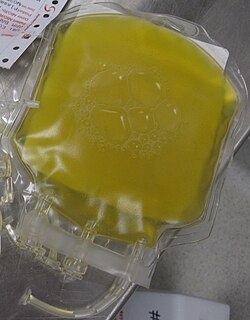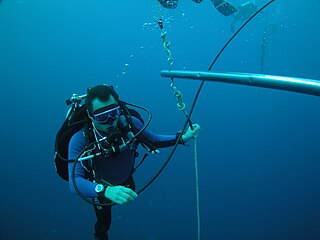This article needs additional citations for verification .(May 2013) (Learn how and when to remove this template message) |
Context-sensitive half-life or context sensitive half-time is defined as the time taken for blood plasma concentration of a drug to decline by one half after an infusion designed to maintain a steady state (i.e. a constant plasma concentration) has been stopped. The "context" is the duration of infusion.

Blood plasma is a yellowish liquid component of blood that normally holds the blood cells in whole blood in suspension. In other words, it is the liquid part of the blood that carries cells and proteins throughout the body. It makes up about 55% of the body's total blood volume. It is the intravascular fluid part of extracellular fluid (all body fluid outside cells). It is mostly water (up to 95% by volume), and contains dissolved proteins (6–8%) (e.g. serum albumins, globulins, and fibrinogen), glucose, clotting factors, electrolytes (Na+, Ca2+, Mg2+, HCO3−, Cl−, etc.), hormones, carbon dioxide (plasma being the main medium for excretory product transportation) and oxygen. It plays a vital role in an intravascular osmotic effect that keeps electrolyte concentration balanced and protects the body from infection and other blood disorders.
In systems theory, a system or a process is in a steady state if the variables which define the behavior of the system or the process are unchanging in time. In continuous time, this means that for those properties p of the system, the partial derivative with respect to time is zero and remains so:
Contents
When a drug which has a multicompartmental pharmacokinetic model is given by intravenous infusion it initially will distribute to the central compartment and then move out of this compartment into one or two peripheral compartments. Once this infusion is discontinued, drug continues to move into the peripheral compartments until an equilibrium is reached. At this time, the only way drug may leave plasma is by metabolism or excretion. As the plasma concentration falls, the concentration gradient of drug reverses and drug moves from peripheral compartments back into plasma, maintaining the plasma concentration of the drug, often prolonging the pharmacological effect. If an infusion has reached steady state then the context-sensitive half-life is equal to the terminal plasma half-life of the drug. Otherwise it will be shorter than the terminal elimination half-life.

Infusion is the process of extracting chemical compounds or flavors from plant material in a solvent such as water, oil or alcohol, by allowing the material to remain suspended in the solvent over time. An infusion is also the name for the resultant liquid. The process of infusion is distinct from both decoction—a method of extraction involving boiling the plant material—and percolation, in which water is passed through the material.

Metabolism is the set of life-sustaining chemical reactions in organisms. The three main purposes of metabolism are: the conversion of food to energy to run cellular processes; the conversion of food/fuel to building blocks for proteins, lipids, nucleic acids, and some carbohydrates; and the elimination of nitrogenous wastes. These enzyme-catalyzed reactions allow organisms to grow and reproduce, maintain their structures, and respond to their environments..

Excretion is a process by which metabolic waste is eliminated from an organism. In vertebrates this is primarily carried out by the lungs, kidneys and skin. This is in contrast with secretion, where the substance may have specific tasks after leaving the cell. Excretion is an essential process in all forms of life. For example, in mammals urine is expelled through the urethra, which is part of the excretory system. In unicellular organisms, waste products are discharged directly through the surface of the cell.
Remifentanil is relatively context insensitive whilst fentanyl and thiopentone are examples of drugs which have significant context-sensitive changes in their half-life. [1]

Remifentanil is a potent, short-acting synthetic opioid analgesic drug. It is given to patients during surgery to relieve pain and as an adjunct to an anaesthetic. Remifentanil is used for sedation as well as combined with other medications for use in general anesthesia. The use of remifentanil has made possible the use of high-dose opioid and low-dose hypnotic anesthesia, due to synergism between remifentanil and various hypnotic drugs and volatile anesthetics.

Fentanyl, also spelled fentanil, is an opioid used as a pain medication and together with other medications for anesthesia. Fentanyl is also used as a recreational drug, often mixed with heroin or cocaine. It has a rapid onset and effects generally last less than two hours. Medically, fentanyl is used by injection, as a patch on the skin, as a nasal spray, or in the mouth.
The Context-Sensitive Half-Time describes the time required for the plasma drug concentration to decline by 50% after terminating an infusion of a particular duration. [2]







